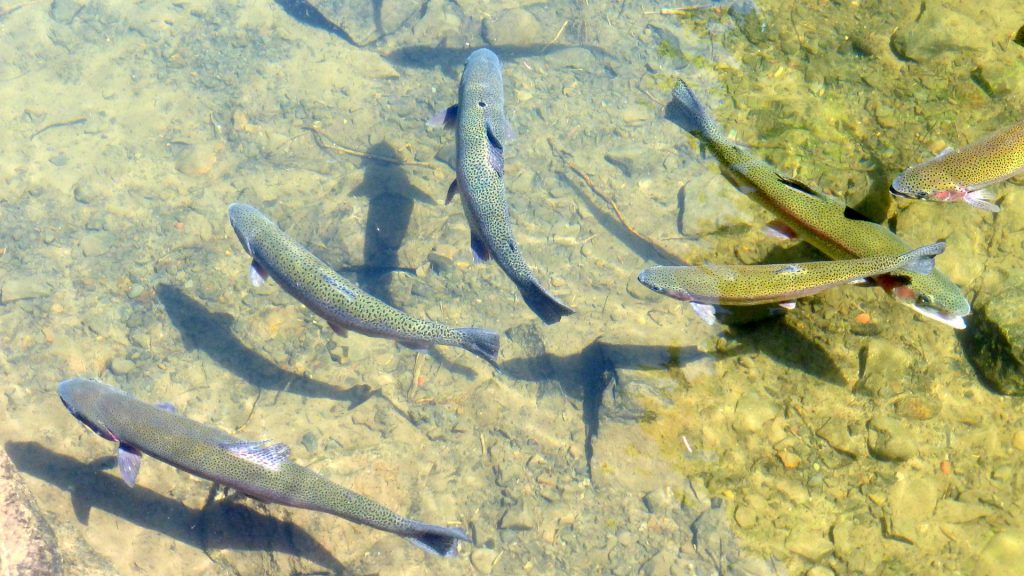Survival of the Fish-est

BY ABIGAIL STOSKY, NATURE NETWORK ASSISTANT
Fish are aquatic animals, which means they spend their whole lives underwater. While we humans can swim or dive in the water, we need special breathing equipment like scuba diving tanks in order to survive for long periods. Fish don’t need any extra equipment. Instead, they have some special adaptations that make life underwater possible. Test out these fish-tastic activities to learn more about how these adaptations work.
What do fish breathe?
What you need
- Pop or other carbonated drink inside a clear bottle
What to do
- Take a look around you. Can you see air surrounding you? Probably not, but that doesn’t mean it’s not there! There is another way we can sense air: by breathing it! Take a deep breath and feel the air fill up your lungs. One of the things that make up air is something called oxygen. Oxygen is very important for many living things because it helps keep us alive. But how do fish get oxygen if they’re surrounded by water instead of air?
- Take a look at the bottle, what do you see inside? Are there any bubbles?
- Open the bottle and look at any changes you see. Now what do you see?
Just like the bubbles were trapped inside the pop, oxygen is trapped inside the water. This trapped oxygen is what fish breathe. But how do they breathe it if it’s trapped inside the water? Try our next activity to find out.
How do fish breathe?
What you need
- Coffee grounds
- Two clear drinking glasses
- Water
- A coffee filter
- Optional: rubber band
What to do
- Fill a drinking glass with water and add some coffee grounds. The coffee grounds will be our pretend oxygen that’s trapped inside water.
- Put a coffee filter on top of the other glass. To make sure it’s secure, you can twist a rubber band around the filter and the top of the glass.
- Slowly pour the glass with the coffee grounds inside onto the coffee filter. What does the water in the coffee filter cup look like? What happens to the coffee filter itself?
Just like the coffee filter traps the coffee grounds, fish have a special organ (called gills) that trap oxygen. One difference between humans and fish is that humans use lungs to remove oxygen from air and fish have gills to remove oxygen from water.
Extra Challenge: Make a swim bladder
Oxygen is a type of gas. Not like the gas that goes into a car, but something that’s hard to see. Air, steam from boiling water, and the farts you toot are all examples of gasses. Fish use gases to help them swim by filling (or emptying) their swim bladder. This helps them float or sink as they need. Try this experiment to see it in action!
What you need
- Small glass bottle (plastic will not work because it’s too light)
- A balloon that fits inside the bottle
- Plastic tubing (at least 30 cm)
- Big tub or container, waterproof and preferable transparent
- The bottle should be able to float inside
- Water
- Strong waterproof tape (ex. duck tape)
- Towels to clean up any spills
Instructions
Make your Swim Bladder
- Attach the balloon to one end of the plastic tube and tape it together. Test to make sure the connection is airtight by blowing into the tube. The balloon should inflate.
- Put the balloon end of the tube into the glass bottle. Tape the opening of the bottle around the tube so water can’t get inside the bottle (but you can still access the tube).
- Fill a big tub with water.
Test your Swim Bladder
- Place the bottle with the balloon inside the tube of water. Keep the other end of the tube outside of the tub. What happens when you place the bottle into the water? Does it float or sink?
- Carefully blow through the tube so the balloon inside the bottle inflates a little bit. Does this change how the bottle is floating? (i.e. does it make the bottle float or sink more?)
- Inflate the balloon even more until it almost fills the whole bottle. What happens?
- Now, let the balloon deflate. What happens?
- Repeat steps 2 – 4 as often as you’d like. To clean up, detach the balloon, tube, and bottle. Dry off your materials and clean up any spills.
What happened?
The glass bottle works like the body of a fish, and the balloon is like the swim bladder. The weight of the glass bottle makes it sink to the bottom of the tub. As scientists would like to say, the weight of the glass bottle is bigger than the force of the buoyancy trying to push it up. But when you blow up the balloon, you add more air into the inside space of the bottle. Because air is lighter than water, the bottle isn’t as heavy anymore. Now that the weight of the bottle is less, the force of buoyancy is strong enough to push the bottle up and start floating. The reverse happens when the balloon deflates.
Adapted from: https://www.sciencebuddies.org/stem-activities/swim-bladder#instructions
